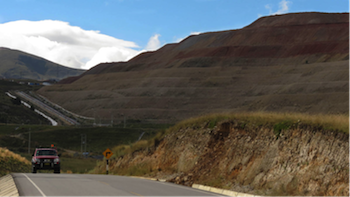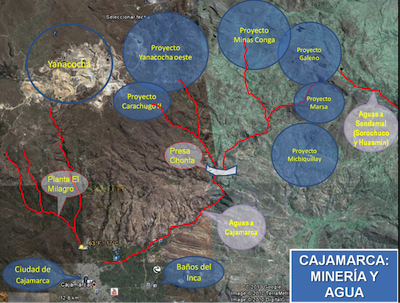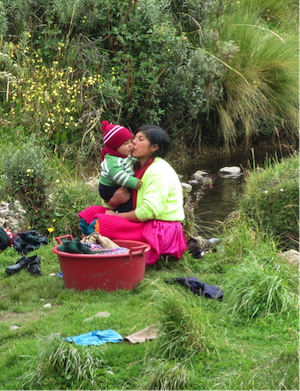I spent nearly a week in Peru’s Cajamarca region in spring of 2013 investigating the controversy around the proposed Conga Mine, which sits atop a plateau nearly 4,000 meters above sea level north of the city of Cajamarca, Perú. The plateau is a massive dome of uplifted metamorphic and sedimentary rock rich valuable minerals like gold, copper and molybdenum. Lower in elevation than other parts of the Peruvian Andes, however, the area lacks snow and ice. The hydrology instead is rain-fed, nourishing high-altitude grasslands called jalgas, as well as alpine lakes and wetlands, or bofedales. These lakes and wetlands are the headwaters of all the streams, rivers, and drinking water for the surrounding areas, including most of Cajamarca’s 250,000 residents.
During my time in Cajamarca, the city and surrounding areas were devoid of tourists, and I was one of just a handful of gringos in the entire city at the time. There was an atmosphere of moderated tension among the residents. Normally, tens of thousands of tourists visit the area every year, as Cajamarca is the location where the Inca Emperor, Atahualpa, surrendered to the Spanish Conquistador, Francisco Pizarro, in 1532. Add to that majestic churches, beautiful hot springs, mountain scenery, and archaeological ruins, and Cajamarca is a truly attractive destination.
Since July, 2012 however, the normal influx of tourists had all but ceased out of concern for traveler safety. Beginning in 2011, large nonviolent protests erupted in Cajamarca city, the nearby cities of Bambamarca and Celendín, as well as in outlying villages over Newmont’s proposed Conga copper and gold mine. The national government had permitted the mine earlier that year via a streamlined process that left the majority of Cajamarqueños feeling marginalized and disempowered. In response, thousands of people poured onto the streets, shutting down highways. To quell the protests, the national government twice declared a state of emergency, calling in the national police with riot gear. Over a period of several days in early July, 2012, five protesters were shot and killed. Many were injured. In all, some fifteen citizens lost their lives, but the mine was put on hold, at least temporarily.

Yanacocha Mine is the fourth largest gold mine in terms of production in the world.
©Ross Geredien
Gold mining has already caused problems with water quantity and quality in Cajamarca. Since 1993, Newmont Mining has operated the Yanacocha Gold Mine, the world’s fourth largest in production, upstream of Cajamarca city in headwaters of the Rio Grande [See photo]. The Rio Grande supplies the drinking water for three quarters of Cajamarca City’s population, and over the years, water quantity and quality have steadily declined.
Nilton Deza, a professor at the National University of Cajamarca, is one of a handful of academics working to educate the public about the threats of additional mining in the watershed. In an interview, Dr. Deza told me that these days, his home in the city only has running water for as little as a few hours per day due to ongoing mining in the headwaters of the Rio Grande. In addition, the water can be contaminated with chlorine by-products. Chlorine is used to treat gold mine waste water and remove cyanide, which helps extract gold from mining ore in a process called heap-leaching. The city’s water treatment systems are currently inadequate to remove these by-products, which can include the carcinogen THM (trihalomethane).
So how has mining affected water quantity? I spoke with Professor Wilder Sanchez about this problem. Dr. Sanchez explained how the excavation of vast open pits causes groundwater to accumulate inside, lowering the water table and consequently lowering the water level in lakes and wetlands, which can become entirely dewatered. By lowering the water table and dewatering alpine wetlands, surface runoff decreases dramatically. The Yanacocha mine has two large open pits in the headwaters above Cajamarca. According to Sanchez, the Conga Mine would create two additional large open pits, one 1,400 meters wide and 650 meters deep, the second only slightly smaller. And there are several other large mines proposed on the plateau, including Yanacocha West, The El Galeno copper project, and another called Michiquillay. To the north in Hualgayoc Province are two other mines that are already operating. The cumulative impacts of these current and proposed mines on water resources worry academics, the public, and local officials alike.

Map showing the various mining concessions in Cajamarca Department. The city is in the lower left.
The Yanacocha Mine is visible in the upper left north of the city. Source: GRUFIDES.
“It is a very fragile ecosystem,” stated Cesar Aliaga, Vice President Cajamarca’s regional government. He was showing me a satellite map of the region with the current and proposed mine operations, a total of six, all in the headwaters of the Cajamarca watershed. If the three proposed projects of Michiquillay, Galeno, and Conga were to go into operation, he said, “..the cumulative impacts on the hydraulic recharge system would be very great.” [See map diagram] I was impressed by Aliaga´s deep understanding of the hydrology and the environmental problems posed by mining. He and regional president Gregorio Santos have publicly decried the national government’s push for expanded mining in the region. In fact, during my visit, the regional government sponsored a Labor Day protest rally in the central square, where politicians and community leaders spoke out in opposition to the Conga Mine. The Regional Government’s position on the Conga Mine is understandable when you consider that 78% of Cajamarca’s population opposes it.

A young woman cuddles her young son while washing clothes in a
mountain stream. ©Ross Geredien
Back on the plateau, I saw how pure mountain water is woven into the daily life and vitality of rural Cajamarqueños. Farming and ranching are the primary livelihoods in the countryside, and I often saw livestock drinking from ponds, streams, or channeled ditches. Trout, considered a sustainable food source, are frequently farm-raised in the high altitude wetland streams or occasionally in pens in larger lakes. The most compelling scene I witnessed, however, was that of a young woman and her infant son. She was washing clothes in a small stream on a terrace of green grass in the middle of the streambed. The cool mountain air blew down the pastured slopes in occasional gusts. Pausing her washing to hold her son, who wore a bright red wool cap with white stripes, she gently kissed and nuzzled his rosy, wind-blown cheeks as clear, clean rivulets of water flowed gently by [See photo]. Despite several efforts to do so, I was never able to enter the Minas Conga, but upon seeing this woman and her son, I realized that the people and their relationship to water were the real story here. I wondered for how much longer that woman in her peaceful mountain pasture would be able to use this stream if one of the massive proposed mines were to begin operation nearby. Yes, Peru has experienced dramatic economic growth because of mining, and one could argue that the woman and her family deserve access to tap water provided by a mining company. But Cajamarqueños are proud of their ancestral mountain heritage. And if one thing is clear, they hold these free-flowing mountain waters sacred and will continue to struggle for their protection.


